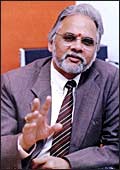 |
| BSE: It now has a Ltd sulfix |
You could soon
trade BSE stocks on the stock exchange. For starters, the Bombay
Stock Exchange has renamed itself BSE Ltd and is considering the
possibility of listing its shares. BSE CEO Rajnikant Patel told
BT that the SEBI (Securities and Exchange Board of India)-prescribed
BSE (Corporatisation and Demutualisation) Scheme 2005 envisages
a reduction in the stake of the current owners from 100 per cent
to 49 per cent. "There could be an offer for sale, an IPO
or a sale to a strategic investor. We will take a final decision
over the next two to three months," he informs. The exchange
is currently owned by a group of stockbrokers.
BSE, Asia's oldest stock exchange, has no outstanding debts and
has a paid-up capital of Rs 75 lakh (each share has a face value
of Re 1). It was established as The Native Share and Stock Broker
Association in 1875 with 300 members. In 1986, it launched the
30-share BSE Sensex, which is considered a barometer for the health
of the country's equity markets. And despite ceding its numero
uno position to the National Stock Exchange, it remains among
the two top stock exchanges in the country (and the most photographed!).
More than 4,700 companies are listed on the exchange, which logs
an average daily turnover of Rs 3,600 crore. A BSE deposit-based
membership costs Rs 95 lakh and its membership roster boasts 800
names. "We have a strong background and corporatisation will
gives us greater operational flexibility," says Patel.
-Krishna Gopalan
TCS
Goes On A Drug Hunt
The software company's new project involves
delivering not codes, but molecules.
 |
| TCS's Vidyasagar: Breaking new ground |
About
four years after Tata Consultancy Services set up its advanced
technology centre for life sciences in Hyderabad in anticipation
of the bioinformatics boom, the it major is getting to sink its
teeth into a very different project. "For the first time
for TCS, a project deliverable is not a piece of code, but molecules,"
says M. Vidyasagar, Executive Vice President (Advanced Technology),
TCS. The company's brave new project is courtesy a deal it struck
with Congenia, an Italy-based biotech start-up, in June this year
after five months of talks. As part of the deal, TCS will provide
"advanced fragment-based lead optimisation solutions for
drug discovery". In English, that means TCS will run highly
sophisticated computer simulations to identify one or more molecules
that will bind to-and thus inhibit the action of-a protein in
the body called "P66", which is associated with ageing.
TCS will also rope in other research labs for offline "wet
lab tests". Congenia will take the molecules through animal
tests and human trials and, if successful, to the market.
The euro 1.1-million (Rs 5.72 crore) contract
is to be executed over 18 months, and marks TCS' entry into the
"lead identification and optimisation" market, which
accounts for 15 to 18 per cent of the $40 billion (Rs 1,76,000
crore) drug-makers spend on drug discovery annually. A typical
drug, according to Vidyasagar, costs between $700 million (Rs
3,080 crore) and $1.2 billion (Rs 5,280 crore) to test and takes
eight to 12 years to bring to the market. TCS will be using its
own software product, "Bio-Suite", developed under the
New Millennium Indian Technology Leadership initiative of CSIR,
to screen thousands of potential lead molecules.
At present, Vidyasagar's team comprises just
34 people, of whom 10 have been put on the Congenia project. But
if he's able to deliver the goods, TCS' fledgling division may
take on a life of its own.
-E. Kumar Sharma
Travails
Of The Travel Agent
Direct online selling of airline tickets and
wafer-thin margins are killing the agents.
 |
| No buyers:
The middleman is dying |
The domestic
aviation market is in full throttle. This year, it is expected
to add five million new passengers to last year's 15 million,
and continue adding another five million every year for the next
five. But this spectacular growth, fuelled by tumbling ticket
prices, has brought little cheer to the 2,000-odd travel agents.
Says Travel Agents Association of India (TAAI) President Balbir
S. Mayal: "The commission on ticket sales has come down from
9 per cent three years ago to 5 per cent. It could come down to
nil eventually." When that happens, most of the travel agents
will be forced out of business. Currently, 80 per cent of the
domestic tickets are sold via travel agents, but low-cost carriers
like Air Deccan are fast changing the equation. Half of Air Deccan's
ticket sales are direct. Will the agents survive the zero-commission
regime? "Air travel sold alone will not help. They will need
to be bundled with other services like medical tourism,"
says Kamal Hingorani, Vice President at Kuoni Academy of Travel.
It's a difficult reinvention that not too many of the travel agents
will manage.
-Kumarkaushalam
POLICY
WATCH
Fiscally Imprudent
The NREGS can derail the government's budgetary estimates.
 |
| The Bill
is placed: But will it solve their problems |
On
August 18, 2005, the congress party made history in more sense
than one. First, it introduced the populist National Rural Employment
Guarantee Bill in the Lok Sabha. Secondly, its President, Sonia
Gandhi, made her first speech in Parliament since the party's
return to power, lauding the Bill as "the human face of economic
reforms that makes economic growth more inclusive and equitable".
Thirdly, it promised a job guarantee scheme that was legally binding
on the government; earlier schemes were all launched by executive
fiat.
The Bill-which seeks to provide 100 days
of employment to at least one member of every rural household
at a minimum daily wage of Rs 60-holds much promise, claim its
advocates. It will help build rural infrastructure, stem the flow
of migration to large cities and address the problem of unemployment
at the grassroots. This, they maintain, will reduce social tensions
and tackle the problem of burgeoning slums in the country. But
others say the additional financial outlay will throw budgetary
estimates out of gear, sharply increase the fiscal deficit, raise
interest rates significantly and hurt the bond market. According
to economist Surjit Bhalla, the scheme is likely to push the combined
fiscal deficit of the Centre and the states, which is at about
10 per cent of GDP, up by 4-4.5 per cent. "It will sound
the death knell for the low interest regime," he says.
The main issue is the absence of reliable
statistics on the number of beneficiaries targeted by the scheme;
therefore, its cost can't be estimated with any degree of certitude.
The Planning Commission says it will cost about Rs 13,000 crore
in the inaugural year, when it will be implemented in 200 of the
country's 600 districts (it will be expanded to cover all the
districts over the next five years). Not everyone agrees with
this assessment. Some estimates place the cost in the inaugural
year at Rs 40,000 crore. "There will be input costs, insurance
and other expenses in addition to the wages," argues Subir
Gokarn, Chief Economist at credit rating agency CRISIL. This is
not counting the cost of the three-tier administrative machinery
that will administer the scheme.
But raising funds is only one part of the
problem. Implementation is the other. "Given the quality
of our administration, feather bedding-maintaining fake registers
of employees-is a real possibility," says Gokarn. Such cases
have been reported under the Maharashtra Employment Guarantee
Scheme-a state-level job guarantee scheme. Moreover, it is easier
to implement such schemes in areas where projects are already
underway, than in areas where projects will have to be implemented
from scratch. So, the better-off states are likely to gain more
than their poorer cousins.
But the biggest question is whether a guaranteed
employment scheme can actually be a sound strategy for mass-scale
employment generation. "It can only act as a rural safety
net in times of emergencies, and can never be a substitute for
regular employment," says Gokarn. Real employment is generated
only when the corporate sector starts recruiting more workers
for its factories. That will happen only when labour reforms-a
euphemism for hire and fire policies-are undertaken. The example
of the services sector is there for all to see: flexible labour
policies have led to the creation of millions of jobs there, and
transformed India into the back-office of the world. The prescription
for tackling unemployment in the country, therefore, should include
more market-driven policies rather than grandiose schemes that
can, potentially, create more problems than they solve.
-Ashish Gupta
ROW
A Heavy Metal Scare
 |
| Ayurvedic
potions: Threat to Big Pharma? |
On
July 14, 2005, health Canada, the health regulatory agency of
Canada, issued a warning to consumers not to use certain ayurvedic
medicinal products on health safety grounds. The provocation:
a batch of Himalaya Drug Company's Karela Capsule, among other
drugs made by different companies, which allegedly breached the
permissible lead content of 5 PPM (parts per million). Health
Canada also published "a list of unapproved ayurvedic medicinal
products... found to contain high levels of lead, mercury and/or
arsenic." Big ayurvedic players like Dabur, Hamdard and Zandu
Pharmaceuticals were named on the list.
Conspiracy theories started circulating when
IIT, Chennai, and Rigaku, a Woodland, Texas-based lab, which carried
out tests on the same batch of Karela Capsule samples, found lead
content of less than 2 PPM, well within permissible limits. "We
are happy that the government has taken up the issue with the
Canadian government," says S.K. Mitra, Executive Director
(Research & Technical Services), Himalaya Drug.
On August 15, 2005, Britain issued a similar
advisory against ayurvedic products. These can seriously impact
the prospects of Indian companies, which have carved a niche for
themselves in the global market for alternative medicines.
Is this a genuine health scare? Or is it
just a one-off incident that's been blown out of proportion? The
jury is still out on that.
-E. Kumar Sharma
"Content
Creators Will Bloom"
 |
| Yahoo! Research's
Raghavan: Wants to be the information intermediary |
In
end-July, Prabhakar Raghavan,
44, took over as the Head of Yahoo! Research. An IIT, Chennai
alumnus and a PhD from the University of California at Berkeley,
Raghavan is currently editor-in-chief of the "Journal of
the ACM", a prestigious peer-reviewed journal published by
the Association for Computing Machinery (ACM), and is a consulting
professor of computer science at Stanford University. Prior to
joining Yahoo!, Raghavan was the Chief Technology Officer at Verity,
Inc. and before that he worked for 14 years at IBM's Almaden Research
Centre. Raghavan spoke to Anil Padmanabhan
in New York on his job and the future direction of change
in cyberspace. Excerpts:
What attracted you to this job?
It is an incredible and exhilarating opportunity.
The opportunity here is to literally
touch billions of lives as they create and consume content. The
thought that drove the web was that people are creative and have
a desire to publish. The web has now provided the medium to permit
this. We want to take this to the next step, where people create
content and enrich content. And we at Yahoo! want to be the intermediary
that handles information in the marketplace.
What will be your focus as the head of
Yahoo! research?
Yahoo! Research's operational strategy lays
down five focus areas: Search and Information retrieval; Enhancing
the user experience; Large scale distributed computing; Monetising
the content that will be collaboratively created on the internet;
and, finally Data Mining to improve the experience of 400 million
users. The web is growing exponentially; given the finite capacity
of individuals to consume information, one can begin to collect
that portion of the web and annotate your favourite portion. This
begins to give rise to a compelling social media experience that
will bring this information into view of a user. Here what we
have is the implicit use of a trust network and not the retrieval
of information through a simple search by key words.
This week is the 10th anniversary of the
Netscape IPO. What is the cyber topography likely to look like
in the next 10 years?
For one, there will be the phenomenon of a
long tail of content creators-not only will there be a surge in
volume, but also in the number of content creators. Secondly,
the content will not be static html-it can be a podcast or animation.
We will have tools that will make it easier to express and create
such content. Thirdly, this content will be more dynamic-a stream
of content that is emanating from us. What you have to expect
is that as these streams grow, people begin to combine their networks.
They could use a digital library of old movies to create their
own selection of movies. Hence, you begin to see much more of
such social media experiences.
Will the revenue model-pop-up ads etc.-too
be redefined in the emerging environment?
The revenue model will move from simply placing
advertisements in static search engines. Almost the entire revenue
will move to dynamic content. Mindset (at Yahoo! Research) is
an interesting experience we put out there. It literally allows
you to indicate your mindset. One way of thinking about this is
to allow you to control the tone of information-like a knob on
a television set is used to flip channels.
At the same time you are aware that there
has been a shift from mass media to personal media; that is, where
the consumer is making the choice of when he/she reads and what
they read. What is the message being spelt out here for content
providers?
There is an interesting thing going on here.
Let us try and view this in two layers. The editorial function
is one of imparting trust. Today there are relatively small numbers
of editors doing this. Going forward this function gets distributed
over a large population-individuals are free to disseminate information.
The second layer is that a billion people do not have time to
vet the content, hence there is a role for an intermediary to
better filter that content such that people can participate and
not be overwhelmed.
|









